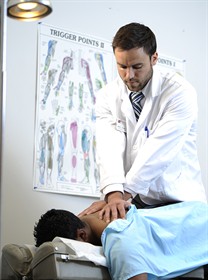A new study published in the Journal of the American Medical Association (JAMA) adds to the growing research that supports spinal manipulation therapy for alleviating low back pain, a common ailment that affects millions of Americans.
Researchers analyzed the data of more than 1,700 patients with lower back pain and found that spinal manipulation was safe and effective in both reducing pain and improving function. Patients reported greater ease in performing everyday activities along with being able to walk more quickly and sleep more soundly.
“Chiropractic medicine can be very effective for pain relief while allowing the body to heal naturally on its own,” said Chris Arick, DC, MS, assistant dean of chiro practic medicine at National University of Health Sciences. “In many cases, no further intervention is needed.”
practic medicine at National University of Health Sciences. “In many cases, no further intervention is needed.”
The study follows the new guidelines released by the American College of Physicians suggesting those with low back pain use various complementary and alternative medicine techniques including spinal manipulation before resorting to medication.
Low back pain is one of the most common reasons doctors prescribe addictive opioid pain medications. Today, the health care community is making efforts to combat an opioid overdose epidemic widespread throughout the United States. Opioids (including prescription opioids and heroin) killed more than 33,000 people in 2015, more than any year on record, according to the Centers of Disease Control and Prevention.
The JAMA study found that spinal manipulation results in pain relief similar to over-the-counter medication but without the harmful side effects that can include risk of liver damage, gastritis and ulcer formation along with adverse drug interactions. Stronger opioids can also result in addiction.
In an editorial published with the study, researcher Dr. Richard Deyo, an internist and professor of evidence-based medicine at  the Oregon Health and Science University, says repositioning of disc matter through spinal manipulation therapy may help reduce muscle tension and stimulate nerve fibers. Deyo also noted that chiropractic medicine remains popular among the public and has the largest portion of highly satisfied patients, according to Consumer Reports.
the Oregon Health and Science University, says repositioning of disc matter through spinal manipulation therapy may help reduce muscle tension and stimulate nerve fibers. Deyo also noted that chiropractic medicine remains popular among the public and has the largest portion of highly satisfied patients, according to Consumer Reports.
In addition to spinal manipulation, chiropractic medicine students at National University learn a variety of treatment modalities that include nutritional and lifestyle counseling, physical rehabilitation therapy and targeted supplementation including vitamins and natural herbal medicines. Along with these natural medicine modalities, the curriculum at NUHS also covers pharmaceutical mechanisms of medications, including opioids, drug-supplement/botanical interaction, drug-nutrient depletions, and pharmaceutical side effects so that students can better holistically understand their patients’ conditions once they get into practice.
“Studies like this mark the growing shift in the medical community that is steering away from medication use as a first line of pain treatment in favor of safer and less invasive treatments,” Dr. Arick said. “Because our students specialize in these natural heath care methods, they are well-positioned for the future ahead.”




0 Comments